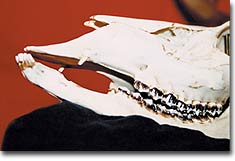September 22, 2010
By Gordon Whittington
Have you ever heard of a whitetail with "fangs?" That just might be the best way to describe this bizarre trophy!
By Gordon Whittington
 Although canine teeth are uncommon in whitetails, there's no missing them in this buck's upper jaw. Photo by Bruce Rose. |
Until the fall of 1995, New York's Bruce Rose had never imagined that a whitetail could grow anything other than a normal set of teeth. But then, as the hunter examined the fine trophy he'd bagged that season, he discovered something strange: a canine tooth protruding from each side of the animal's upper jaw. For all the world, the teeth looked like a pair of fangs!
"Tell hunters of the Northeast to keep an eye out for the meat-eating bucks," Bruce joked to us here at North American Whitetail. But all kidding aside, what might cause such an oddity - and how rare is it in whitetails?
Advertisement
Let's tackle the second question first. Although canine teeth aren't part of a whitetail's normal dentition, they aren't unheard of, either. I've observed them on a few whitetails in Illinois, and taxidermists elsewhere occasionally discover them while caping. The canines are always well under an inch in length, even on older deer, so others probably are going unnoticed. Besides, how many hunters even would think to look for them?
Why do such teeth occur? The answer involves genetics - prehistoric genetics, to be more exact. The whitetail evolved from deer that originated in Asia tens of millions of years ago, and at least some of those early species had canines. In fact, even today some Old World species have pronounced canines. For example, various small Asian deer called muntjacs feature upper canines that in adult males are prolonged into "tusks." And the male musk deer often has 3-inch "tusks."
Advertisement
While the whitetail's genetic link to its Asian ancestors has weakened over the eons, the gene for these vestigial teeth is still out there. And when the right buck and doe mate, the trait potentially can show up in their offspring. At least, it can in their male progeny. It's reported that whitetail does never grow canines, though they certainly can pass on the gene to the next generation of deer.

